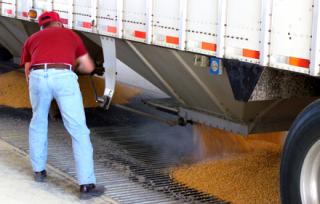The corn and soybean crops in the U.S. are massive. Monday's USDA Crop Production report shows the soybean crop continues to skyrocket in size, but the corn crop's slightly smaller than earlier estimates. Now, speculation's rising that consumption may well keep up with this year's production, which could mean a return to grain profits in the next marketing year, one economist says.

Monday's USDA Crop Production report estimated the U.S. soybean crop will be 31 million bushels larger than last month's guess, totaling just shy of 4 billion bushels. The report also showed a corn crop of 14.4 billion bushels, 68 million bushels short of the October estimate.
The data's mostly neutral, analysts say. But, Tuesday's market has soybeans rocketing higher while corn's unchanged. Shouldn't these numbers be reversed? Fundamentally, that should be the case. Why the reversal?
"The market’s mostly neutral reaction to today’s numbers may be due in part to the fact that current supplies of all grains are adequate but not at record levels, whereas current projected demand for corn and soybeans are at record levels and wheat demand, while not a record, remains strong," says Teucrium Trading broker and market analyst Sal Gilbertie. "Investors and asset allocators may be eying the grain markets for a potential cyclical harvest low as harvest comes to a close in the Northern Hemisphere."
See More: November USDA Crop Report 'Neutral'Check Back & Follow Along With Monday's Report & Reactions
It's all about consumption, says University of Illinois Extension ag economist Darrel Good. Ethanol use has steadily climbed, but exports are slightly behind where they need to be to reach an ending-stocks number of 1.75 billion bushels, a key number the market will start watching closely. But, production and consumption seem to be on their way to converging at a point at which supplies could start to tighten further, especially if prices remain low and exports to nations like Argentina and Brazil -- where they've declined in the last month -- pick up as a result.
Ultimately, there are a couple of key messages to take from Monday's reports, Good says. First, yes, these crops are massive this year. But, stocks haven't moved higher at the same rate. That means those stocks could continue to tighten.
"If current production and consumption forecasts actually verify, the big story this year will be that extremely large corn and soybean crops resulted in less than burdensome year ending stocks. The modest level of stocks relative to the consumption base opens the door for a tighter supply and consumption balance for the 2015-16 marketing year, particularly for corn If consumption next year remains near the projected level for this year, a corn crop less than 13.66 billion bushels would result in a drawdown in stocks," Good says. "With a national average yield at the trend value of 163 bushels per acre, harvested acreage would have to increase by about 700,000 acres to produce a crop greater than 13.66 billion bushels. Similarly, with acreage at this year's level, the national average yield would have to be at 164.4 bushels to produce a crop of 13.66 billion bushels."
It's even tighter for soybeans, Good adds. "The soybean picture is a little different. If soybean consumption next year continues at the level projected for this year, a crop less than 3.615 billion bushels would result in a drawdown in year ending stocks," he says. "A trend yield of 44.3 bushels per acre would require harvested acreage of only 81.6 million to produce a crop of 3.615 billion bushels. That is 1.8 million fewer acres than expected to be harvested this year."
Ultimately, Good says this all means that corn and soybean prices may not jump to the upside anytime too soon, but looking longer-term, there's reason to believe profitability could be back in the cards for the next marketing year.
"While the large harvest this year will keep prices at relatively low levels, particularly for corn, the odds now favor prices that will be profitable for both corn and soybean producers in 2015-16," he says.





